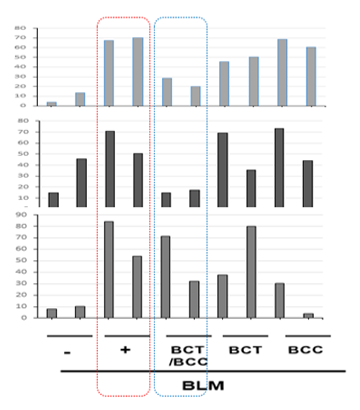Recently, BCC and BCT were chemically synthesized as a new chemical entity, ACH251. The data below are derived from the combined preparations of BCC and BCT before chemical synthesis, and the reproducibility of the efficacy and safety of ACH251 is currently being evaluated and will be updated as soon as related data are released.
Confirming Efficacy of ACH251 in Cellular Study ModelStudy results showed that lung epithelial cells treated with BCC/BCT Combo had a decreased expression of hypoxia-induced HIF-1α was observed in 24 hours, followed by reduced fibrotic markers in 48 hours with statistical significance compared with untreated control cells as indicated. Overall ACH251’s efficacy in cellular model study was validated in animal model studies.
-

HIF-1α
-

NOX2
-

NOX4
-

α-SMA
-

Fibronectin
-

Col4
-

-

* In vitro human lung epithelial cells A549 were treated with TGF-ß (10μg/ml), BGC(2μΜ) or both.
Study results also showed that BCC/BCT Combo attenuated levels of bleomycin-induced fibrotic triggers and makers with statistical significance.
Study results showed that mice treated orally with BCC/BCT Combo had a reduction of 42% in the amount of scarred tissue compared with control mice as measured by Trichrome staining and modified Ashcroft scoring while mice treated orally with 60mg/kg of Nintedanib had a reduction of 40% in the amount of scarred tissue confirming that BCC/BCT Combo is an effective anti-fibrotic agent for IPF.
-

ACH251
-

Nintedanib



